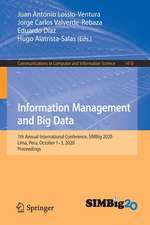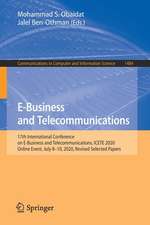Internet of Things: Concepts and System Design
Autor Milan Milenkovicen Limba Engleză Paperback – 19 mai 2021
Written in a reader-minded approach that starts by describing the problem (why should I care?), placing it in context (what does this do and where/how does it fit in the great scheme of things?) and then describing salient features of solutions (how does it work?), this book covers the existing body of knowledge and design practices, but also offers the author’s insights and articulation of common attributes and salient features of solutions such as IoT information modeling and platform characteristics.
| Toate formatele și edițiile | Preț | Express |
|---|---|---|
| Paperback (1) | 333.54 lei 6-8 săpt. | |
| Springer International Publishing – 19 mai 2021 | 333.54 lei 6-8 săpt. | |
| Hardback (1) | 510.75 lei 6-8 săpt. | |
| Springer International Publishing – 19 mai 2020 | 510.75 lei 6-8 săpt. |
Preț: 333.54 lei
Preț vechi: 416.93 lei
-20% Nou
Puncte Express: 500
Preț estimativ în valută:
63.84€ • 69.37$ • 53.66£
63.84€ • 69.37$ • 53.66£
Carte tipărită la comandă
Livrare economică 21 aprilie-05 mai
Preluare comenzi: 021 569.72.76
Specificații
ISBN-13: 9783030413484
ISBN-10: 3030413489
Pagini: 306
Ilustrații: XII, 306 p. 56 illus., 21 illus. in color.
Dimensiuni: 155 x 235 x 21 mm
Greutate: 0.45 kg
Ediția:1st ed. 2020
Editura: Springer International Publishing
Colecția Springer
Locul publicării:Cham, Switzerland
ISBN-10: 3030413489
Pagini: 306
Ilustrații: XII, 306 p. 56 illus., 21 illus. in color.
Dimensiuni: 155 x 235 x 21 mm
Greutate: 0.45 kg
Ediția:1st ed. 2020
Editura: Springer International Publishing
Colecția Springer
Locul publicării:Cham, Switzerland
Cuprins
1. Introduction and Overview.- 2. The Edge.- 3. Communications.- 4. Cloud.- 5. Security and Management.- 6. IoT Data Models and Metadata.- 7. IoT Data Standards and Industry Specifications.- 8. IoT Platforms.- 9. Putting it All Together.- Index.-
Recenzii
“The book gives a comprehensive overview of IoT systems that includes such aspects as security, privacy, data models, interoperability, and protocols, and ends with a real-world example: a personal office energy monitor. It is a must-read for practitioners in the field who want a bigger picture, as well as anyone who wants to enter the field of IoT and understand its concepts and implications.” (Massimiliano Masi, Computing Reviews, November 16, 2021)
Notă biografică
Milan Milenkovic is a founder of IoTsense LLC, an IoT technology development and strategy consultancy in the San Francisco Bay Area. As a principal engineer in Intel Labs and in IoT Business Unit he led a number of projects involving IoT system architecture and implementation, smart buildings and energy management, cloud and grid computing. Prior to Intel, he worked at IBM Company and in academia conducting research and leading prototyping of a variety of emerging technology projects.
Milan Milenkovic earned M.Sc. degree in Computer Science from Georgia Institute of Technology and a Ph.D. in Electrical and Computer Engineering from the University of Massachusetts at Amherst. He has given invited talks at academic and industrial conferences and has authored a number of journal and conference papers, industry technical reports, standards, and U.S. and international patents. He is the author of the textbook Operating Systems: Concepts and Design (McGraw-Hill), a monograph on distributed database systems, and an IEEE tutorial on multimedia systems. He is a Fulbright Scholar, an ACM Distinguished Engineer and a Senior Member of IEEE.
Textul de pe ultima copertă
This comprehensive overview of IoT systems architecture includes in-depth treatment of all key components: edge, communications, cloud, data processing, security, management, and uses. Internet of Things: Concepts and System Design provides a reference and foundation for students and practitioners that they can build upon to design IoT systems and to understand how the specific parts they are working on fit into and interact with the rest of the system. This is especially important since IoT is a multidisciplinary area that requires diverse skills and knowledge including: sensors, embedded systems, real-time systems, control systems, communications, protocols, Internet, cloud computing, large-scale distributed processing and storage systems, AI and ML, (preferably) coupled with domain experience in the area where it is to be applied, such as building or manufacturing automation.
Written in a reader-minded approach that starts by describing the problem (why should I care?), placing it in context (what does this do and where/how does it fit in the great scheme of things?) and then describing salient features of solutions (how does it work?), this book covers the existing body of knowledge and design practices, but also offers the author’s insights and articulation of common attributes and salient features of solutions such as IoT information modeling and platform characteristics.
- Comprehensive and balanced coverage provides a rounded and solid foundation for students and practitioners to build upon when designing IoT systems and components, and to confidently evaluate their options when choosing components and partners/vendors to complement their solutions
- Reader-minded approach: starts by describing the nature and significance of issues and problems so that readers are better motivated to understand solutions, including why they matter, where they fit, and how they work
- System-first approach: starts by describing the big picture and how the overall system works so that readers can interpret subsequent in-depth topical coverage in context
- Systems aspects and integration: in addition to describing the functional and foundational aspects of all major IoT system components, the book emphasizes integration throughout, i.e. how the components and building blocks are combined to create complete IoT systems. This is in contrast to most alternative approaches that tend to describe piece parts as independent isolated topics, without much guidance on how to put them together
- Emphasizes IoT data and information modeling, interoperability and the related standards. Data interoperability is viewed as a key technical requirement for IoT
Caracteristici
Comprehensive and balanced coverage provides a rounded and solid foundation to students and practitioners to build upon when designing IoT systems and components, and to confidently evaluate their options when choosing components and partners/vendors to complement their solutions Reader-minded approach: starts by describing the nature and significance of issues and problems so that readers are better motivated to understand solutions, including why they matter, where they fit, and how they work System-first approach: starts by describing the big picture and how the overall system works so that readers can interpret subsequent in-depth topical coverage in context Systems aspects and integration: in addition to describing the functional and foundational aspects of all major IoT system components, the book emphasizes integration throughout, i.e. how the components and building blocks are combined to create complete IoT systems. This is in contrast to most alternative approaches that tend to describe piece parts as independent isolated topics, without much guidance on how to put them together Emphasizes IoT data and information modeling, interoperability and the related standards. Data interoperability is viewed as a key technical requirement for IoT





























